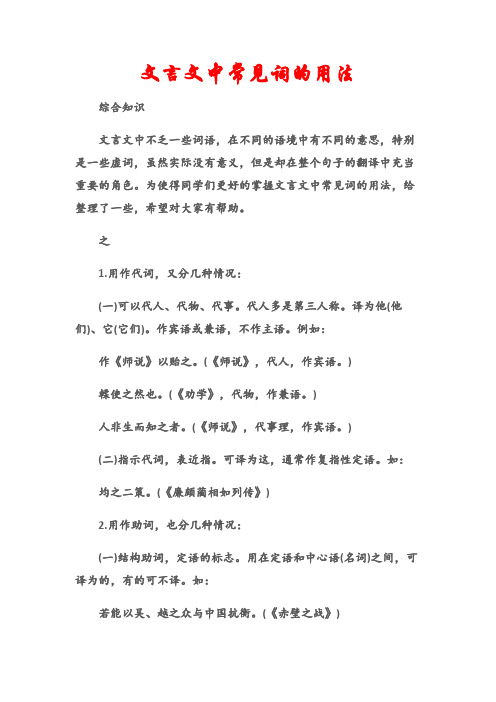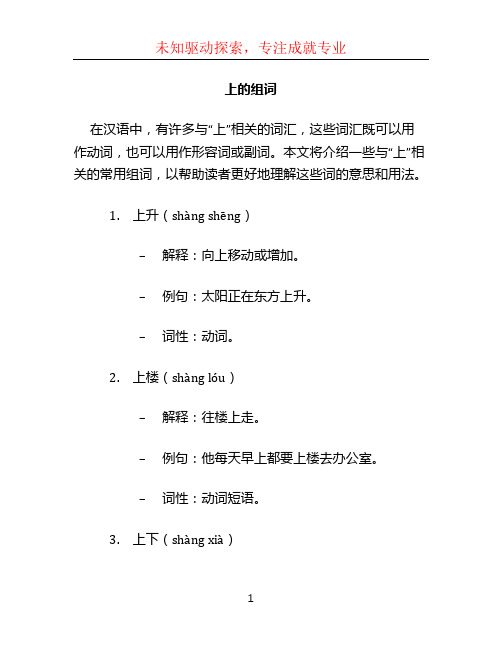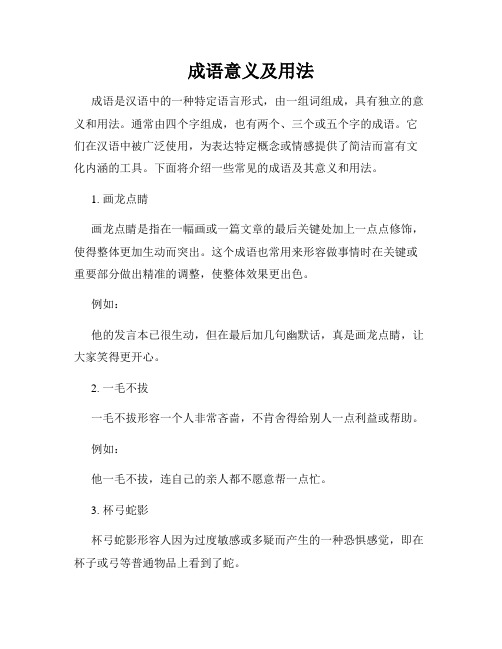常用组词的用法1
部编版一年级上册语文第五单元知识点

第一节:词语解释1. 词语:指语言中具有独立意义的最小单位。
2. 词义:词语所表示的含义或概念。
3. 词形:词语的形态结构,包括词根、前缀、后缀等。
4. 词性:词语在句子中所表示的语法作用,包括名词、动词、形容词等。
第二节:词语造句1. 词语组词:将词语按照一定的规则组合起来,形成有意义的词组或句子。
2. 造句要求:词语组合要符合语法规则,表达清晰、准确。
3. 培养方法:通过阅读、听讲、模仿等方式培养学生造句能力。
第三节:词语分类1. 根据词义:分为实词和虚词两大类。
实词:具有实际意义的词语,如名词、动词、形容词等。
虚词:没有实际意义,用来表示语法关系的词语,如连词、助词等。
2. 根据词性:根据词语在句子中的语法功能进行分类,如名词、动词、形容词、副词等。
第四节:词语的读音1. 拼读规则:根据汉字的发音规律和声调来正确读音。
2. 遇到复杂音节:通过语音学的知识和练习来掌握复杂音节的读音。
3. 识字技巧:通过多读多练,掌握不同音节的发音规律,提高识字能力。
第五节:词语的用法1. 根据上下文选择合适的词语:根据语境和逻辑关系,选择适合的词语进行表达。
2. 形近词、异义词辨析:通过比较和练习,掌握形近词和异义词的用法和区别。
3. 词语搭配:学习词语的常用搭配,提高语言表达的准确性。
第六节:词语的拼写1. 基本规则:掌握基本的字母拼写规则,包括声母、韵母、声调等。
2. 识别生字:通过分解词语、查字典等方法,掌握生字的拼写。
3. 词语辨析:通过练习,掌握容易混淆的词语的拼写和用法。
第七节:常见错误1. 主要表现:包括错别字、词语搭配错误、语法错误等。
2. 纠错方法:通过课堂教学、作业批改等方式,指导学生纠正错误,提高语言表达水平。
第八节:词语记忆1. 记忆技巧:包括联想、重复、归纳等方法,帮助学生记忆词语的意义和拼写。
2. 扩展词汇:通过词语扩展、记忆词语的构词法,扩大词汇量,提高语言表达能力。
第一节:词语解释词语是语言中具有独立意义的最小单位。
二字组词高级词汇

二字组词高级词汇
一、“旖旎”(yǐ nǐ,形容词)
1. 词义。
- 本为旌旗随风飘扬的样子,引申为柔和美丽,多用来描写景物。
- 例如“旖旎的风光”,描绘出景色的柔美、迷人。
2. 用法。
- 常作定语,如“旖旎的水乡景色”;也可作谓语,如“这片山林风光旖旎”。
二、“氤氲”(yīn yūn,形容词)
1. 词义。
- 指湿热飘荡的云气,也有充满、弥漫的意思。
- 例如“氤氲的雾气”,形容雾气弥漫的样子。
2. 用法。
- 可作定语,如“氤氲的水汽笼罩着湖面”;也可作谓语,如“整个山谷氤氲着神秘的气息”。
三、“缱绻”(qiǎn quǎn,形容词)
1. 词义。
- 形容情意深厚、难舍难分。
- 例如“缱绻的情思”,表达情感的缠绵。
2. 用法。
- 作定语,如“缱绻的爱意”;作谓语,如“他们之间的感情缱绻”。
四、“踯躅”(zhí zhú,动词)
1. 词义。
- 徘徊不前的样子。
- 例如“他在路口踯躅,不知该往哪里去”。
2. 用法。
- 多作谓语,如“那匹马在栅栏前踯躅”。
五、“睥睨”(pì nì,动词)
1. 词义。
- 有斜着眼看,侧目而视,有厌恶或高傲之意。
- 例如“他睥睨着那些趋炎附势的小人”。
2. 用法。
- 作谓语,如“她站在高处睥睨着众人”。
语文组词知识点归纳总结

语文组词知识点归纳总结一、什么是组词组词是指将两个或两个以上的字组合在一起,形成语言单位的过程。
通常情况下,组词是由形音或形义相关的字组合而来,这些组合具有固定的用法和意义。
二、组词的常用方法1.形声组词:形声组词是指一个字在字的结构上表明该字的意义,而在发音上表示另一个字。
比如,"木"字和"朵"字组成"朵"字,"木"字表示的是"树"的意思,"朵"字的发音是"duǒ"。
2.形容组词:形容组词是指一个字在形状、内容上与其他字有一定的联系,两个字组合在一起,表示某种意义。
比如,"月"字和"明"字组成"明"字,"月"字表示的是"月亮"的意思,"明"字表示的是"亮"的意思,两者组合表示"月亮明亮的意思。
3.合成组词:合成组词是指两个或两个以上的字组合而成的词,这种词的意义是由各个组成部分共同决定的。
比如,"飞"字和"机"字组成"飞机"这个词,这个词的意义是"飞行工具"。
4.转注组词:转注组词是指一个字由另一个字引申而来的,表示某种意义。
比如,"春"字由"人"字和"艹"字组成,表示"春天"的意思。
5.引申组词:引申组词是指一个字由另一个字引申而来,表示某种意义。
比如,"家"字由"豕"字和"宀"字组成,表示"屋子"的意思。
6.转注引申组词:转注引申组词是指一个字由另一个字转注而来,再引申而来的词。
(综合知识)文言文中常见词的用法

古之圣人,犹且从师而问焉(《师说》)
2.用作副词。相当于将将要,暂且姑且。
不出,火且尽。(《游褒禅山记》)
驴一鸣,虎大骇,远遁;以为且噬已也,甚恐。(《黔之驴》)
存者且偷生,死者长已矣!(《石壕吏》)
卿但暂还家,吾今且报府。(《孔雀东南飞》)
所
1.用作助词。经常放在动词前,同动词结合,组成所字结构。所字结构是名词性短语,表示所的人、所的事物、所的情况等。如:
若能以吴、越之众与中国抗衡。(《赤壁之战》)
道之所存,师之所存也(《师说》)
(二)结构助词,补语的标志。用在中心语(动词、形容词)和补语之间,可译为得。如:
古人之观于天地、山川、草木、鸟兽,往往有得,以其求思之深而无不在也。(《游褒禅山记》)
(三)结构助词,宾语前置的标志。用在被提前的宾语之后,动词谓语或介词之前,译时应省去。如:
位卑则足羞,官盛则近谀。(《师说》)
入则孝,出则弟。(《论语学而》)
(四)表示转折、让步关系。表示意思有转折时,则字用在后一分句,可译为可是却;表示姑且承认一件事,预备下句转入正意时,则字用在前一分句,可译为虽然倒是。例如:
于其身也,则耻师焉,惑矣。(《师说》)
其室则迩,其人甚远。(《诗经东门之》)
2.用作副词。用在判断句中,起强调和确认作用,可译作是就是。例如:
此则岳阳楼之大观也。(《岳阳楼记》)
非死则徙尔。(《捕蛇者说》)
且
1.用作连词。
表示递进关系、并列关系。
彼所将中国人不过十五六万,且已久疲(《赤壁之战》)
且将军大势可以拒操者,长江也(《赤壁之战》)
河水清且涟漪。(《伐檀》)
有时相当于尚且,先让步,后推进一层。
mean的用法及词组

mean的用法及词组一、Mean的基本用法Mean是一个常见的动词,表示“意味着”、“表达某种意思”,在英语中广泛使用。
它可以作为及物动词,也可以作为不及物动词。
下面我们将详细介绍mean的基本用法以及一些常见的搭配和短语。
1. Mean作为及物动词当mean作为及物动词时,常接名词或代词作宾语,并可以搭配不同的介词来表达特定的涵义。
例如:- What does this word mean?(这个单词是什么意思?)- Money means power to some people.(对一些人来说,金钱代表权力。
)- He meant no harm.(他并无恶意。
)2. Mean作为不及物动词当mean作为不及物动词时,通常会与介词to连用,表示“打算”或“计划做某事”。
例如:- I mean to go to the gym every day this week.(我打算这周每天去健身房。
)- She means to apply for a scholarship next year.(她计划明年申请奖学金。
)3. 慣用語中的mean除了基本用法外,mean还在许多慣用語中出现,并赋予了特定的含义。
- By all means: 肯定,无论如何- I'll help you by all means.(我一定会帮助你。
)- Mean business: 认真对待,严肃处理- The boss means business when he calls a meeting.(老板召开会议表示他认真对待此事。
)- No mean feat: 不容易做到的事情- Winning the championship is no mean feat.(赢得冠军不是件容易的事。
)二、Mean的常见词组和短语除了基本用法外,mean还与很多其他词组和短语结合使用,扩展了它的意义和应用范围。
以下是几个常见的mean词组和短语的用法介绍:1. Mean to do something:打算做某事这个短语中的to作为介词,后接不定式形式的动词来表达某种意向或计划。
上的组词文档

上的组词在汉语中,有许多与“上”相关的词汇,这些词汇既可以用作动词,也可以用作形容词或副词。
本文将介绍一些与“上”相关的常用组词,以帮助读者更好地理解这些词的意思和用法。
1.上升(shàng shēng)–解释:向上移动或增加。
–例句:太阳正在东方上升。
–词性:动词。
2.上楼(shàng lóu)–解释:往楼上走。
–例句:他每天早上都要上楼去办公室。
–词性:动词短语。
3.上下(shàng xià)–解释:表示从高处到低处或从低处到高处。
–例句:他来回爬上下山。
–词性:方向副词。
4.上级(shàng jí)–解释:地位或级别较高的人或组织。
–例句:请向你的上级领导报告此事。
–词性:名词。
5.上旬(shàng xún)–解释:月份的前十天。
–例句:我们计划在下个月的上旬去旅游。
–词性:名词。
6.上课(shàng kè)–解释:到教室或特定地点参加课程。
–例句:明天我们要早点到学校上课。
–词性:动词短语。
7.上班(shàng bān)–解释:到工作地点开始工作。
–例句:我每天早上七点钟上班。
–词性:动词短语。
8.上网(shàng wǎng)–解释:连接到互联网并使用网络服务。
–例句:我喜欢利用空闲时间上网看新闻。
–词性:动词短语。
9.上衣(shàng yī)–解释:指外层的衣物,如上衣、外套等。
–例句:今天天气有点冷,记得穿一件保暖的上衣。
–词性:名词。
10.上报(shàng bào)–解释:向上级提供信息或报告。
–例句:请尽快将最新的数据上报总部。
–词性:动词短语。
11.上马(shàng mǎ)–解释:开始进行一项活动或计划。
–例句:我们决定在明天上午九点上马新项目。
–词性:动词短语。
12.上飞机(shàng fēi jī)–解释:进入飞机并开始飞行。
journey、voyage、trip、tour、travel的用法区别1解读

journey、voyage、trip、tour、travel的用法区别这一组词都有“旅行”的意思,但各词的含义有所不同。
1. journey指从一地到另一地,通常指陆地上的远距离“旅行”,有时也可以表示经常走的或长或短的“路程”。
只作名词。
例如:I took a journey from Beijing to Shanghai last year.-- How long is your journey to school? --Only about 10 minutes.2. voyage主要指远距离的水上旅行,也可以指空中旅行意思为“航海、航空、航行”等。
只作名词。
例如:She usually gets seasick during the voyage.They made a voyage across the Pacific by air.3. trip 一般指时间短、距离近的“旅行、远足”,也可以指长途旅行。
在非正式用语中可代替journey。
只作名词。
例如:We made a boat trip to the island last week and had a good time.I will be on a trip to / journey to the south next summer holiday.4. tour 着重指旅行线路比较曲折,常表示“(周游各地的)参观、访问、(巡回)旅游、视察、购物、演出”等意思。
可作动词和名词。
例如:I will tour the world in the future.My father has gone down-town on a shopping tour.5. travel作“旅行、游历”解,一般表示从一地到另一地旅行这一总的概念。
常指长时间、远距离的“旅行”。
尤指出国旅行。
可作动词和名词。
其复数形式意思为“旅游笔记”、“游记”。
二年级语文组词造句打印

二年级语文组词造句打印字号: 小三行距: 1.5倍段前后间距: 0行在二年级语文课上,组词造句是一项重要的任务。
这项任务旨在帮助学生扩展词汇量、提高语言表达能力。
以下是一些二年级学生常用的组词和造句示例:【动物类】1. 狗:小明养了一只可爱的小狗。
2. 猫:姐姐家里有一只黑白相间的小猫。
3. 鱼:弟弟在池塘里钓了一条大鱼。
【水果类】1. 苹果:妈妈给我买了一个大红苹果。
2. 香蕉:我喜欢吃又香又甜的香蕉。
3. 葡萄:爸爸种了一棵结满葡萄的藤蔓。
【食物类】1. 面包:早上,妈妈给我做了一个美味的面包。
2. 米饭:晚饭时,我吃了一碗白热的米饭。
3. 鸡蛋:奶奶煮了一些鸡蛋给我们吃。
【家具类】1. 桌子:我在桌子上完成了作业。
2. 椅子:我坐在椅子上看书。
3. 床:晚上,我躺在舒适的床上入睡了。
【颜色类】1. 红色:这个苹果是红色的。
2. 黄色:太阳变成了一个大黄球。
3. 蓝色:天空上飘着几朵白云,蓝色的天空很美丽。
【天气类】1. 晴天:今天是一个晴天,阳光明媚。
2. 雨天:外面下着大雨,小朋友们躲在家里。
3. 风:风吹起了树叶,发出沙沙的声音。
【人物类】1. 妈妈:妈妈是我最爱的人。
2. 爸爸:爸爸每天都陪我一起玩耍。
3. 姐姐:姐姐帮我解答了一个难题。
【学科类】1. 数学:数学是一门有趣的学科。
2. 语文:我喜欢上语文课,老师讲得很生动。
3. 英语:我正在学英语,为了将来能去国外旅行。
通过组词造句,我们可以更加深入地了解一个词的含义和用法。
对于二年级的学生来说,增加词汇量对他们的学习非常重要。
通过不断练习组词和造句,他们的语文能力将不断提高。
希望以上的例句可以帮助二年级的小朋友们更好地学习语文。
高中英语常见20组词汇、词义及用法辨析

高中英语常见20组词汇、词义及用法辨析高中英语常见20组词汇、词义及用法辨析到濮阳:在做英语试题的时候,你是否经常遇到这样的情况:几个选项,词义意思相近,似乎选哪一组都是正确的,让你很是纠结,无所适从。
今天小编就给同学们整理高中阶段常见的二十组词义相近的单词用法辨析,解决困扰你的问题!1.accuse / chargeuse 和charge都有“指责,控告”之意,有时可通用,但结构不一样。
accuse不一定针对重大过失或罪行,其结构为accuse sb of sth。
而charge一般用于重大过失或罪行,其结构为charge sb with sth,此结构还有“使某人负有……责任”之意。
例如:例1:My father accused me of my being too careless. (父亲责备我太粗心。
)例2:He accused me of neglecting my duty. (他指控我玩忽职守。
)例3:He charged me with neglecting my duty. (同上)例4:Jimmy was charged with murder. (吉米被控谋杀。
)例5:He was charged with an important task. (他担负有一项重要任务。
)2.add / add to / add up / add up toadd:增加,把……加上。
add…to…:把……加到。
例如:例6:At the end of the party, we added another program.例7:You n eedn’t add any water to the medicine.add to:增添。
指增添喜悦、悲伤、麻烦等。
例如:例8:His coming added to our trouble. (他的到来给我们添了麻烦。
)add up:加起来。
例如:例9:Have you added up all the numbers?add up to:总计。
人教版二年级上册全部生字组词大令

一、生字组词1.大:大象、大衣、大桥、大楼、大米2.令:令人、令人愉快、令人钦佩、令人难忘、令人陶醉二、生字组词的用法生字组词是指根据学习的生字,通过组合起来成为一个词语,并掌握其使用方法。
在人教版二年级上册中,教材中出现了许多生字,通过组词的方式进行学习,可以帮助学生更好地掌握生字的意义和用法。
1. 大象:大象是一种大型动物,是世界上的象科动物的统称,具有长鼻子和长牙,常生活在热带雨林中。
2. 大衣:大衣是一种长款外套,用于防寒保暖,常见于冬季穿着。
3. 大桥:大桥是指跨越江河、峡谷等地形的建筑物,用于便利交通。
4. 大楼:大楼通常指高层建筑物,多用于办公、商业等用途。
5. 大米:大米是一种主食作物,是我国人的主要食品之一。
1. 令人愉快:这是一个描述心情的词组,即让人感到愉快、开心的意思。
2. 令人钦佩:这是一个表示赞赏的词组,即让人感到钦佩、敬佩的意思。
3. 令人难忘:这是一个描述记忆的词组,即让人难以忘记的意思。
4. 令人陶醉:这是一个形容情感的词组,即让人陶醉、沉浸其中的意思。
三、如何利用生字组词进行教学教师可以针对学生的芳龄特点,通过游戏、竞赛等形式,让学生通过生字组词的方式进行学习。
可以设置情景游戏,让学生在游戏中运用生字组词,从而更好地掌握生字的意义和用法。
可以设置小组竞赛,由学生自己动手组词,并进行讲解和展示,增强学生的学习兴趣,培养他们的观察力和动手能力。
四、生字组词的作用通过生字组词的学习,不仅可以帮助学生更好地掌握生字的意义和用法,还可以培养学生的观察力、联想力和动手能力。
生字组词也可以帮助学生加深对词语的理解,提高语文素养,为学生打下良好的语文基础。
五、生字组词的教学建议为了更好地开展生字组词的教学工作,教师需要结合学生的实际情况,设置多种形式的组词活动,激发学生的学习兴趣。
教师可以设计一些富有趣味性的活动,如歌曲、游戏等,使学生在愉快的氛围中学习生字组词,达到事半功倍的效果。
成语意义及用法

成语意义及用法成语是汉语中的一种特定语言形式,由一组词组成,具有独立的意义和用法。
通常由四个字组成,也有两个、三个或五个字的成语。
它们在汉语中被广泛使用,为表达特定概念或情感提供了简洁而富有文化内涵的工具。
下面将介绍一些常见的成语及其意义和用法。
1. 画龙点睛画龙点睛是指在一幅画或一篇文章的最后关键处加上一点点修饰,使得整体更加生动而突出。
这个成语也常用来形容做事情时在关键或重要部分做出精准的调整,使整体效果更出色。
例如:他的发言本已很生动,但在最后加几句幽默话,真是画龙点睛,让大家笑得更开心。
2. 一毛不拔一毛不拔形容一个人非常吝啬,不肯舍得给别人一点利益或帮助。
例如:他一毛不拔,连自己的亲人都不愿意帮一点忙。
3. 杯弓蛇影杯弓蛇影形容人因为过度敏感或多疑而产生的一种恐惧感觉,即在杯子或弓等普通物品上看到了蛇。
例如:他因为曾经受过蛇咬的刺激,对一切看见的东西都会有杯弓蛇影,总是感到恐惧。
4. 掩耳盗铃掩耳盗铃形容虽然明知是错误的事情,却故意掩耳盗铃般地听不见,自欺欺人。
例如:他听到了大家对他的劝告,但掩耳盗铃地继续前进,最终遭受了失败的结局。
5. 指鹿为马指鹿为马是指明明是鹿,却说成是马,用以形容故意颠倒黑白、混淆是非的行为。
例如:他明明知道事实的真相,却故意指鹿为马,试图误导大家的判断。
6. 自相矛盾自相矛盾指一个人的话或行为之间存在着明显的矛盾和不一致。
例如:他先声称自己非常关心环境保护,然后却经常乱扔垃圾,这种行为实在自相矛盾。
以上只是一些常见的成语及其意义和用法。
成语因其独特的表达方式和深厚的文化内涵,在我们的日常交流中起到了重要的作用。
熟练运用成语不仅能丰富我们的语言表达,还能够增加文化修养,传递更准确的信息。
因此,我们应经常学习和使用成语,提高自己的语言水平,更好地与他人交流。
journey、voyage、trip、tour、travel的用法区别1

journey、voyage、trip、tour、travel的用法区别这一组词都有“旅行”的意思,但各词的含义有所不同。
1. journey指从一地到另一地,通常指陆地上的远距离“旅行”,有时也可以表示经常走的或长或短的“路程”。
只作名词。
例如:I took a journey from Beijing to Shanghai last year.-- How long is your journey to school? --Only about 10 minutes.2. voyage主要指远距离的水上旅行,也可以指空中旅行意思为“航海、航空、航行”等。
只作名词。
例如:She usually gets seasick during the voyage.They made a voyage across the Pacific by air.3. trip 一般指时间短、距离近的“旅行、远足”,也可以指长途旅行。
在非正式用语中可代替journey。
只作名词。
例如:We made a boat trip to the island last week and had a good time.I will be on a trip to / journey to the south next summer holiday.4. tour 着重指旅行线路比较曲折,常表示“(周游各地的)参观、访问、(巡回)旅游、视察、购物、演出”等意思。
可作动词和名词。
例如:I will tour the world in the future.My father has gone down-town on a shopping tour.5. travel作“旅行、游历”解,一般表示从一地到另一地旅行这一总的概念。
常指长时间、远距离的“旅行”。
尤指出国旅行。
可作动词和名词。
其复数形式意思为“旅游笔记”、“游记”。
语文组词的技巧和方法

语文组词的技巧和方法语文组词的技巧和方法是指在学习和使用语文词汇时,通过一定的技巧和方法来扩充和巩固词汇量,提高语文表达和理解能力的能力。
下面我将详细介绍语文组词的技巧和方法。
一、读书积累词汇1.广泛阅读:通过广泛的阅读,包括文学作品、历史资料、科普读物等,可以接触到各种语言风格和主题内容,丰富自己的词汇库。
2.边读边记:在阅读时,遇到生词或者常用词的新意时,及时记录下来,并进行梳理和总结,形成自己的词汇表。
3.列读书笔记:读书时可以记下一些重要、生僻或者有趣的词汇,并进行注释和用法总结,方便之后的复习和巩固。
4.注意词性和词义的变化:同一个词在不同的句子和语境中,其词性和词义可能会发生变化,要注意学习和掌握这种变化。
二、学会积极利用词典1.多种类型的词典:学习语文可以使用各种类型的词典,如汉语词典、成语词典、英汉对照词典等,通过学习其中的释义、近义词、反义词等提高词汇量和应用能力。
2.课外拓展:在学习过程中,可以使用词典拓展自己的词汇库,比如在写作时遇到思维瓶颈时可以查找相关的词汇,提高表达能力。
三、学会归纳总结1.相似词归类:将相似的词归类并集中记忆,如动物类词汇、植物类词汇等,可以帮助记忆和理解。
2.组词练习:通过组织和运用已学词汇进行组词练习,培养语感和提高运用能力。
四、词根词缀法1.了解词根和词缀:通过学习和了解一些常用的词根和词缀,可以帮助理解和记忆更多的词汇。
2.运用词根和词缀分析词义:在遇到不认识的词汇时,可以根据其中的词根和词缀进行词义推测,提高自己的词汇理解能力。
五、单词联想法1.联想记忆:通过将新学词汇与已知词汇进行联想,可以帮助记忆和理解。
2.构建词语网络:将相关的词汇进行整理和归类,构建一个词语网络,可以帮助记忆和运用。
3.使用词语搭配:学习词语时可以注意其常见搭配,通过搭配记忆词汇,提高语言表达能力。
六、运用词语法1.学习词语的变形:通过学习和掌握词语的变形形式,如派生词、屈折变化等,可以提高对词汇的掌握和应用能力。
大组词的分类和用法

大组词的分类和用法大组词是由两个或更多个汉字连在一起组成的词语。
根据其构造方式和功能特点,大组词可以分为以下几类:1. 名称组词:由两个或更多个汉字组成,用于表示某个事物、概念、人物的名称。
例如:“冰箱”、“电视”、“海鲜”等。
这类大组词通常具有明确的指代意义,是日常生活中常用的词汇。
2. 功能组词:由两个或更多个汉字组成,用于表示某种功能、动作或动态。
例如:“走廊”、“跳舞”、“生长”等。
这类大组词常用于描述具体的行为或状态,是丰富语言表达的重要方式。
3. 描述组词:由两个或更多个汉字组成,用于表示某种特征、性质或状态。
例如:“冰冷”、“轻盈”、“充满”等。
这类大组词常被用来形容事物的形状、性质或状态,增强了语言表达的生动性。
4. 聚合组词:由两个或更多个汉字组成,用于表示由多个事物或概念组合而成的复合物。
例如:“大学生”、“社会主义”、“南北极”等。
这类大组词常使词语具有整体性和统一性,反映了事物间的内在联系。
要正确使用大组词,需要注意以下几点:1. 熟悉组词规律:根据组词的构造方式和功能特点,理解不同类型的大组词的含义和用法。
2. 严格遵循用字规范:大组词的构词方式较为严格,要遵循一定的用字规范。
例如:“飞机”不能写成“飞劲”、“开车”不能写成“开车光”。
3. 注意正确拼写:大组词的拼写要遵循规范,注意字词之间的搭配和连接。
例如:“公共场所”不能写成“公共场所地”。
4. 注意语境运用:根据具体语境和表达需求,选择合适的大组词进行表达。
在不同的语境中,同一个大组词可能具有不同的含义和用法。
大组词在汉语中起着丰富语言表达的作用。
通过正确理解其分类和用法,我们能够更准确地运用大组词,丰富自己的语言表达能力。
十组词的用法

十组词的用法
“十组词”是一种中文词汇分类方法,即将词汇按照意义、词性、用法等方面进行分类,每类用一个数字表示,共有十类。
以下是“十组词”的用法:
1. 数字词:表示数量和顺序的词汇,如“一、二、三、四、五、六、七、八、九、十”等。
2. 方位词:表示方向和位置的词汇,如“上、下、左、右、前、后、东、西、南、北”等。
3. 时间词:表示时间的词汇,如“年、月、日、时、分、秒”等。
4. 颜色词:表示颜色的词汇,如“红、橙、黄、绿、青、蓝、紫”等。
5. 亲属词:表示亲属关系的词汇,如“父亲、母亲、儿子、女儿、哥哥、姐姐、弟弟、妹妹”等。
6. 人体词:表示人体部位的词汇,如“头、脸、眼、耳、口、鼻、手、脚”等。
7. 动物词:表示动物的词汇,如“狗、猫、鸟、鱼、虫、马、牛、羊”等。
8. 植物词:表示植物的词汇,如“树、花、草、菜、果”等。
9. 食物词:表示食物的词汇,如“饭、面、菜、肉、鱼、蛋、奶”等。
10. 学习用品词:表示学习用品的词汇,如“笔、纸、书、本、橡皮、尺子”等。
以上是“十组词”的基本用法,通过这种分类方法,可以帮助我们更好地学习和记忆中文词汇。
归组词的分类和用法

归组词的分类和用法如下:
1.按照语义分类:
•归国:指回到自己的国家或故乡。
•归程:指返回或回家的路程或旅途。
•归侨:指海外侨胞回到祖国定居或探亲访友。
•归宁:指女子回到娘家看望父母或探亲访友。
•归真返璞:指回归自然或本真状态。
•归还:指把曾经借来的东西还给原主。
2.按照词性分类:
•归是一个汉字,可以作为动词、名词、形容词等使用。
•作为动词使用时,可以表示回到、趋向、合并、归还等意思,如归国、归程、归真返璞、归还等词。
•作为名词使用时,可以表示回家的路程、返回的地方、聚拢、回归线等意思,如归程、归宿、北回归线等词。
•作为形容词使用时,可以表示纯洁、纯粹、真本等意思,如归真返璞等词。
3.按照词语结构分类:
•归可以和其他汉字组合成词语,如归来、回归、归去、归心等词。
•归还可以和其他词语组合成短语,如归功于、归纳为、属于等短语。
范组词(精选80个)

范组词(精选80个)范组词(一):常用组词拼音和解析(1)示范shì fàn作出某种可供大家学习的榜样或典范:~操作。
起~作用。
(2)模范mó fàn1.值得学习的、作为榜样的人:劳动~。
选~。
2.能够作为榜样的;值得学习的:~事迹。
~人物。
(3)规范guī fàn1.约定俗成或明文规定的标准:语音~。
道德~。
2.合乎规范:这个词的用法不~。
3.使合乎规范:用新的社会道德来~人们的行为。
(4)范围fàn wéi1.周围界限:地区~。
工作~。
活动~。
他们谈话的~很广,涉及政治、科学、文学等各方面。
2.限制;概括:纵横四溢,不可~。
(5)轨范guǐ fàn行为所遵循的标准。
(6)范本fàn běn典范的样本(多指书画):习字~。
(7)就范jiù fàn听从支配和控制:迫使~。
(8)风范fēng fàn风度;气派:大家~。
名将~。
(9)典范diǎn fàn能够作为学习、仿效标准的人或事物:树立~。
~作品。
(10)垂范chuí fàn给下级或晚辈示范;做榜样:~后世。
(11)防范fáng fàn防备;戒备:对走私活动必须严加~。
范组词(二):范字在开头能组的`词语1、范畴2、范仲淹3、范晔4、范公堤5、范宽6、范围7、范蠡8、范进9、范本10、范履霜11、范成大12、范雎13、范文14、范例15、范增范组词(三):范字在中间能组的词语1、师范大学2、高雄师范大学3、彰化师范大学4、典范长存5、霁范永存6、示范户7、模范生8、示范社区9、师范学校10、模范大音阶11、国民礼仪范例12、师范生13、萧行范篆14、模范村15、台湾师范大学16、模范区17、规范学18、科技示范户19、道范长昭20、大通师范学堂21、懿范长昭22、师范教育23、防范得宜24、防范未然范组词(四):范字在结尾能组的词语1、团体规范2、懿范3、简易师范4、格范5、颜范6、淑范7、阃范8、雅范9、班范10、母范11、师范12、鸿范13、模范14、壼范15、小范16、闺范17、容范18、没样范19、仪范20、社会规范21、风范22、典范23、洪范24、明范25、坤范26、轨范27、久违颜范28、示范29、就范30、立范31、科范32、样范33、防范34、规范范组词(五):范字能组的四字成语1、轨物范世2、林下风范3、范张鸡黍4、范水模山5、贻范古今6、垂范百世7、范蠡携美8、大家风范9、陶朱范蠡10、盛德遗范11、模山范水范作文时常在媒体上看到“明星范儿”、“韩范儿”、“中国范儿”等带有“范儿”的词汇;偶尔同朋友聊天时,也常常会听到“他真有范儿啊!”之类;平日行走于街市,也能尽观广告语中的各种“范儿”。
落花生这一课的词语

落花生这一课的词语落花生课文的生字组词包括:落花生、翻耕、深耕、沟渠、基本、妥善、休耕、计较、敏感、营养、丰收、众口难调。
《落花生》是一篇经典的小学生语文课文,在这篇文章中,有很多生字组词需要学生们注意认识和学习,下面是一些常见的生字组词及其意思用法:1、落花生:又称花生或土豆。
是一种常见的植物果实,可以食用或提取油脂。
2、翻耕:即翻转、耕作。
指在农田内犁地、松土、调整土壤结构等操作。
3、深耕:指在翻耕的基础上,再次深入犁地,使土层更松软,以利于作物的生长发育。
4、沟渠:指人工挖掘的水沟和排水沟,用于防止积水和排除雨水。
5、基本:指最基础、最根本的事物或要素。
6、妥善:指处理得当、周密、稳妥。
常用于劝告或建议中。
7、休耕:指为了保护和恢复土地的生态环境,而让土地空置一段时间,不进行农业生产活动。
8、计较:指计算、考虑。
有时候也指争吵、争斗,常用于贬义。
9、敏感:指对一些事物、词语、情境等过敏、易受到刺激或影响。
常用于形容人或心理状态。
10、营养:指食物中所含的各种营养成分,如碳水化合物、蛋白质、脂肪、维生素、矿物质等。
11、丰收:指农作物产量达到很高的水平,有时也是指其他领域的成功和成果。
12、众口难调:指众人意见不一致,难以协调和达成共识。
《落花生》讲述的内容《落花生》是一首经典的中国民歌,它通过描述一位农村妇女的艰辛生活,表达了对劳动者的敬意和对生活的热爱。
以下是《落花生》讲述的内容:这首歌以农村为背景,描绘了一个农妇种地、劳作的场景。
歌词中描述了农妇干劳动的过程和她的心情。
她在艰苦的田野里耕种,夏日的骄阳下,汗水湿透了她的衣襟。
她用辛勤的双手给大地播种,并期待着丰收的季节。
在歌曲中,农妇的辛劳得到了别人的赞美和关注。
她辛勤工作、无私付出,用自己的汗水换来了土地的丰饶。
虽然生活困苦,但她从不放弃,始终保持着对生活的热爱和积极向上的态度。
通过歌曲《落花生》,我们可以感受到农妇对生活的执着和对劳动的尊重。
一年级下册动词组词

一年级下册动词组词
1. 什么是动词组词?
动词组词是由两个或更多个动词组合而成的词语。
它们可以一起形成新的意义,或者表示一连串的动作或状态。
2. 动词组词的用法
动词组词可以丰富语言表达,使描述更加准确生动。
下面是一些常见的动词组词及其用法:
- 做饭:煮饭、炒菜、烧水等
- 打扫:打扫房间、扫地、擦窗等
- 穿衣:穿上衣服、换鞋、系领带等
- 洗澡:洗脸、沐浴、擦干等
- 听音乐:听歌、唱歌、跳舞等
3. 动词组词的练
练是巩固研究的重要方式。
请同学们完成以下句子中的动词组词:
1. 妈妈在厨房里__做饭__。
2. 弟弟每天都会__打扫__自己的房间。
3. 姐姐喜欢__穿衣__时跟妈妈商量。
4. 爷爷每天早上都会__洗澡__。
5. 妹妹喜欢__听音乐__放松。
4. 动词组词的延伸
除了上述常见的动词组词外,同学们还可以尝试创造属于自己
的动词组词。
通过组合不同的动词,你可以创造出新的有趣的词语,丰富你的语言表达。
例如:
- 爬树:爬上树、爬下树、爬过树等。
- 游泳:游泳比赛、游泳练、游泳池等。
动词组词的可能性是无限的,希望同学们加强动词的研究,不断探索动词组词的魅力!
> 注意:本文档内容仅供参考,具体内容以学校教材为准。
节组词的用法

节组词的用法
【汉字】节
【拼音】jiéjiē
【部首】艹
【释义】
●节(節)jié
◎竹子或草木茎分枝长叶的部分:竹节。
节外生枝。
◎物体的分段或两段之间连接的部分:关节。
两节车厢。
◎段落,事项:节节(一段一段地,逐步)。
节目。
◎中国历法把一年分为二十四段,每段开始的名称:节气。
节令。
◎纪念日或庆祝宴乐的日子:节日。
◎礼度:礼节。
◎音调高低缓急的限度:节奏。
节拍。
节律。
◎操守:节操。
晚节。
变节。
高风亮节(高尚的品德和节操)。
◎省减,限制:节省。
节制。
开源节流。
◎略去,简略:节选。
节录。
◎古代出使外国所待的凭证:符节。
使节。
◎姓。
●节(節)jiē
◎〔节骨眼儿〕喻关键的,能起决定性作用的环节或时机(“(節)骨”读轻声)。
【组词】
贯节哈节遁节常节符节亡节
停节违节效节夏节宪节事节岁节送节遂节炎节雪节悬节玉节稚节趁节变节堕节春节促节疏节幢节安节诗节鸿节合节积节虎节佳节机节计节畸节节省节适劲节节朔角节节事戒节节马节信节尚节略节母谨节举节筋节节使节孝。
- 1、下载文档前请自行甄别文档内容的完整性,平台不提供额外的编辑、内容补充、找答案等附加服务。
- 2、"仅部分预览"的文档,不可在线预览部分如存在完整性等问题,可反馈申请退款(可完整预览的文档不适用该条件!)。
- 3、如文档侵犯您的权益,请联系客服反馈,我们会尽快为您处理(人工客服工作时间:9:00-18:30)。
other:作前置定语,修饰单数或复数名词。如:We study Chinese,English and other subjects.
the other:表示两者中的“另一个”或两部分中的“另一部分”,是特指。如:Mr Green has two children,one is a doctor,the other is a teacher.格林先生有两个孩子,一个是医生,另一个是教师。
⑴be going to+原形动词,如:I'm going to have a meeting tomorrow.明天我开会。
⑵shall或will+原形动词,如:I shall have a meeting tomorrow.
但有些动词的现在进行时态表示将来时,如:Jim's coming,too.吉姆也来。
最高级:
⑴三者相比较。如:Which is the biggest,the moon,the sun or the earth?月亮、太阳和地球哪个大?
⑵one of+最高级+名词复数,如:China is one of the biggest countries in the world.中国是世界上最大的国家之一。
borrow与lend互为反义词
⒊may与can的区别
may比can更加客气、委婉。
如:May I borrow your pencil,please?与Can I borrow your pencil,please?其肯定回答都是:Certainly.如果否定回答,回答can时,应是Sorry,you can't.而回答may时,应是No,you mustn't.
另一种方法比较正规,正式文体中常出现。
整点:o'clock, 如:7:00seven o'clock
半点:half past,如:7:30half past seven
几点过几分:past(先表达小的时间单位),如:7:10ten past seven
差几分到几点:to,如:7:40twenty to eight
⒌感叹句中how与what的区别
how修饰形容词、副词;what修饰名词。
句型:How+形容词或副词+主语+谓语, What+a(an)+形容词+名词+主语+谓语.
如:What a fine day it is!多么好的天气啊!How beautiful the flowers are!多好看的花啊!
如:The Reads lives in Beijing. 瑞德家住在北京。The Reads are sitting at the table to have lunch.瑞德一家人正围坐在桌旁吃午饭。
⒊分析句子
Why don't you come a little earlier?
⑴Why don't you do sth.=Why not do sth.后边动词用原形。
如:I've been there three times.
⒉borrow与lend
borrow:借入。借入是对主语而言,后面往往跟from连用。如:I borrow a dictionary from the library.我从图书馆借了一本字典。
lend:借出。借出也是对主语而言,往往与to连用。如:I lent the book to Li Lei.我把那本书借给了李雷。
⒋would like与like的区别
would like=want,would like to do sth.想要做某事,like doing或like to do sth.喜欢做某事。
如:Would you like to have some cakes?你想吃些蛋糕吗?I like singing.我喜欢唱歌。
⑷以重读闭音节结尾的词,而末尾只有一个辅音字母,双写最后这个辅音字母,加er或est。如:big bigger biggest
⑸不规则。举例按原级,比较级,最高级顺序。如:well、good better best bad、ill worse worst many、much more most little less least far farther、further farthest、furthest
little,a little修饰不可数名词,little表示否定,a little表示肯定。
如:Don't worry,there's a little time left.别着急,还有点时间呢。
few,a few修饰可数名词,few表示否定,a few表示肯定。
如:Though he is very rich,he has few friends.He doesn't think he is very happy.虽然他很富有,但他没有几个朋友,他并不感到幸福。
如:He is often at home.He often stays at home.
sometimes(有时)可放在句首或句尾。
词组
a little一点儿
Mid-Autumn Day中秋节
on the day在那天
to look like看上去像
in the open air在户外
当can表示一种能力时,can与may不能互换。如:I Can speak English.
而may表示“允许”,“可以”,如:“May I come in?”
can,may都是情态动词,没有人称和数的变化。情态动词后跟原形动词,如:He can run very fast.主语是第三人称单数,情态动词和后面的动词也都不加“s”。
⑶句末一般带有in或of短语,说明范围的。如:Li Lei is the tallest in his class.
比较级的变化形式:
⑴一般词尾后加er,或est。如:long longer longest
⑵以字母e结尾的词加r或st。如:nice nicer nicest
⑶以辅音字母y结尾的词,把y变i,加er或est。如:early earlier earliest
比较级:
⑴两者相比较。如:The Changjiang River is longer than the Yellow River.长江比黄河长。
⑵much+比较级,表示“比…多”的意思。如:Summer is much hotter than spring.夏天比春天热得多。
⑶比较级,表示“越来越…”如:It gets colder and colder.天气变得越来越冷了。
⑵a little earlier这是比较级的一种表达方法,比较级前往往加上一些修饰词,说明程度。如:a little loger, much hotter
⒈reach,get to,arrive(in,at)的区别
这些词都有“到达”的意思,其区别如下:
reach:及物动词,后跟名词。如:I'll reach Beijing at nine tomorrow.
get:不及物动词,不可直接跟名词,要加上to。如:I'll get to Beijing at nine tomorrow.
词组
Good idea!好主意!
Nothing much没什么事干
a few一些
next week/month下星期/月
have a swim游泳
on Sunday evening在星期天的晚上
much better好多了
on a farm在农场
⒈语法
一般将来时:表示将要发生的动作。一般将来时可以用两种形式表示:
类似这样的词有go,come,leave,arrive等。
⒉ Nothing等不定代词的位置
nothing是不定代词,表示“没有东西”,是否定词。类似这样的词还有something,anything,somebody,any,someone,anyone,everything等。
这些词与形容词连用时,形容词放在这些不定代词的后面。如:I have something important to tell you.我有重要的事要告诉你。
词组
work hard努力工作
(be)hard to reach难够着,难摸到
get on a bus上公共汽车
be careful小心
hold a ladder扶着梯
climb up爬上去
comeபைடு நூலகம்down下来
quite near很近
much bigger大得多
a quarter to five四点四十五分
have a good time玩得很愉快
all the time一直
go boating去划船
a little earlier/later早/晚一点
⒈时间表达法
表示时间有两种方法,一种是直接翻译法,如:3:40three forty, 2:10two ten
一刻:a quarter,7:15a quarter past seven,7:45a quarter to eight
⒉表示“一家人”的表达法
如:the Reads,瑞德一家人,Read瑞德是个姓,前面加定冠词the,后面加s表示一家人。它是个集体名词,视为一个整体,动词用第三人称单数;如果视为家庭成员们或者夫妇两人,则动词用复数形式。
